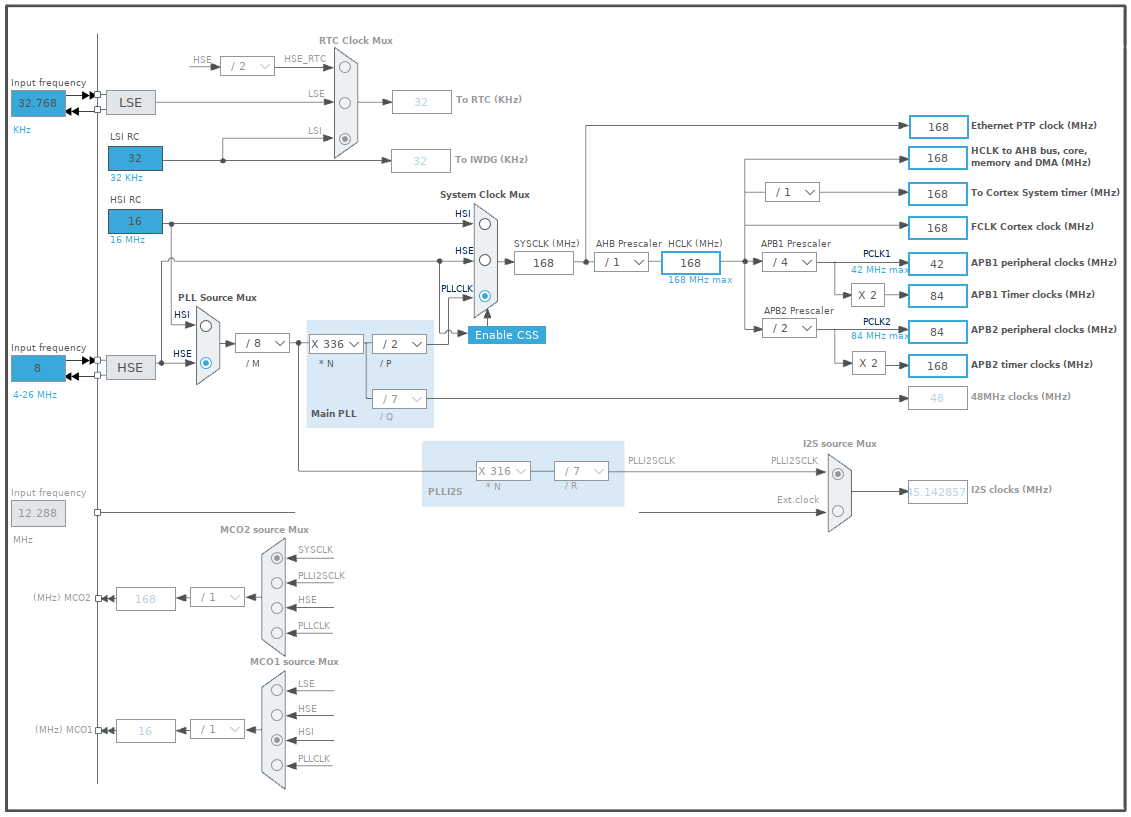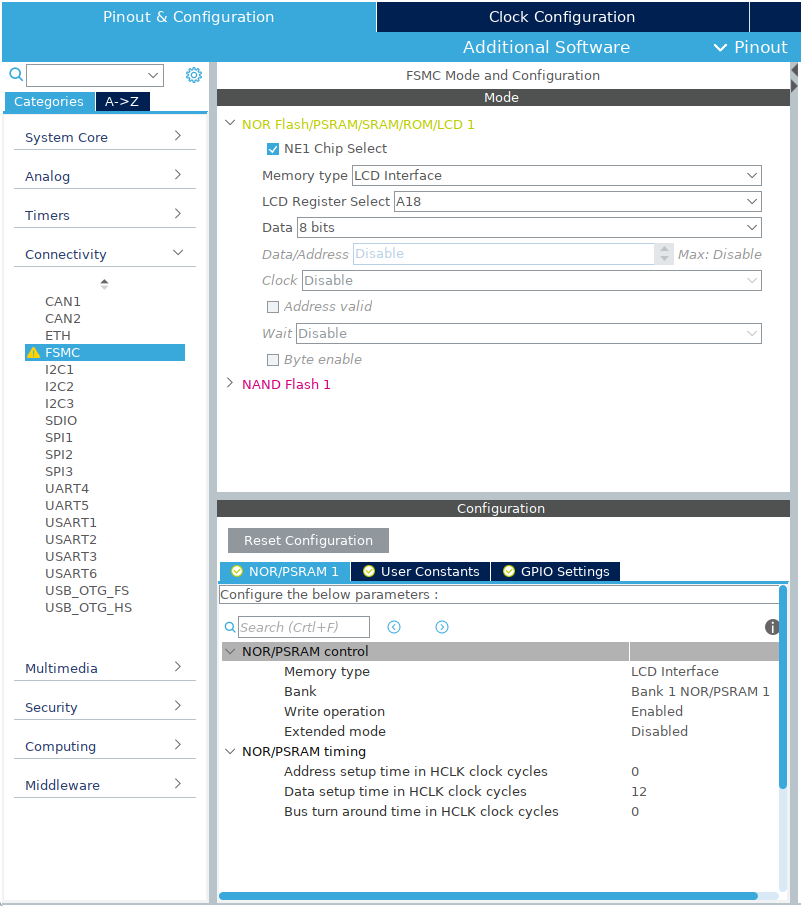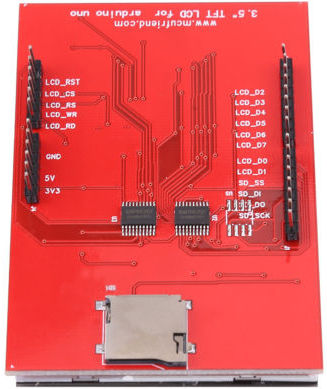3.5" inch TFT LCD Display Module 480X320 driven with FSMC.
TFT LCD Display Module 480X320 driven with FSMC
I have recently bought a 3.5" inch TFT LCD Touch Screen Display Module 480X320 with a www.mcufriend.com label on the back side. The display was equipped with an 8bit parallel interface. First I decided to test it with the UniGraphic library using the BUS_8 protocol. The display was very slow but improved when I switched to the PAR_8 protocol. Because I heard about the possibility to use a Flexible Static Memory Controller (FSMC), built into some STM MCU's, to drive LCD's (read/write to LCD's memory rather than to an external SRAM) I thought it would be a fun to try it out.

Below is the brief story of what I did:
- Created a project for my STM32F407VE board in the STM32CubeIDE
- Set the
Clock Configurationto match the one used by Mbed for the Seeed Arch Max board:
- Selected
FSMCin theConnectivitycategory and configured it as below:
- Let the
STM32CubeIDEgenerate the code (files). - Created a new program for the Seeed Arch Max target in the Mbed Online Compiler by selecting a
mbed os blinkytemplate. - Replaced the
main.cppwith themain.ccontent of theSTM32CubeIDEproject. Copy & Pastedthe other files with codes from theSTM32CubeIDEproject to the online compiler project.- Renamed and modified:
"stm32f4xx_it.h" to "stm32f4xx_it_msp.h"
"stm32f4xx_it.c" to "stm32f4xx_it_msp.c" - Added the UniGraphic library to the online compiler project.
- Extended the
UniGraphiclibrary with aFSMC_8protocol and replaced theTFT::set_orientation(int orient)function with the one used bymcufriendfor arduino. - Modified the
main.cppas needed.
 |  |
Wiring
| STM32F407VE | TFT LCD module |
|---|---|
| +3.3V | 3V3 |
| GND | GND |
| PB_12 | LCD_RST |
| GND | LCD_CS |
| PD_13 (RS) | LCD_RS |
| PD_5 (WR) | LCD_WR |
| PD_4 (RD) | LCD_RD |
| PD_14 (DB00) | LCD_D0 |
| PD_15 (DB01) | LCD_D1 |
| PD_0 (DB02) | LCD_D2 |
| PD_1 (DB03) | LCD_D3 |
| PE_7 (DB04) | LCD_D4 |
| PE_8 (DB05) | LCD_D5 |
| PE_9 (DB06) | LCD_D6 |
| PE_10 (DB07) | LCD_D7 |
Results
| Execution times | ||
|---|---|---|
| Used protocol | BUS_8 | FSMC_8 |
| Operation \ Time | ms | ms |
| Clear | 2283.980 | 38.454 |
| Plot | 192.066 | 11.365 |
| 8bit BMP | 63.805 | 41.338 |
| Large Font | 163.872 | 7.895 |
| Sparce pixels | 2072.265/1458.051 | 74.107/52.168 |
| 16bit BMP | 2288.589 | 59.904 |
UniGraphic/Inits/ST7565.cpp
- Committer:
- hudakz
- Date:
- 2020-09-25
- Revision:
- 1:47c996032a9e
- Parent:
- 0:fa952828e34c
File content as of revision 1:47c996032a9e:
/* mbed UniGraphic library - Device specific class
* Copyright (c) 2015 Giuliano Dianda
* Released under the MIT License: http://mbed.org/license/mit
*/
#include "Protocols.h"
#include "ST7565.h"
/*this is a quite standard config for ST7565 and similars, like UC1701*/
//////////////////////////////////////////////////////////////////////////////////
// display settings ///////////////////////////////////////////////////////
/////////////////////////////////////////////////////////////////////////
#define IC_X_SEGS 132 // ST7565 SEG has range 0-131 (131-0 if ADC=1), check your datasheet, important for the orientation
#define IC_Y_COMS 64 // ST7565 COM has range 0-63 (63-0 if SHL=1), check your datasheet, important for the orientation
// put in constructor
//#define LCDSIZE_X 128 // display X pixels, ST7565 is advertised as 132x65 but display size could be smaller
//#define LCDSIZE_Y 64 // display Y pixels, the 65th is for accessing "icons"
ST7565::ST7565(proto_t displayproto, PortName port, PinName CS, PinName reset, PinName DC, PinName WR, PinName RD, const char *name, unsigned int LCDSIZE_X, unsigned int LCDSIZE_Y)
: LCD(displayproto, port, CS, reset, DC, WR, RD, LCDSIZE_X, LCDSIZE_Y, IC_X_SEGS, IC_Y_COMS, name)
{
hw_reset();
BusEnable(true);
init();
cls();
set_orientation(1);
locate(0,0);
}
ST7565::ST7565(proto_t displayproto, PinName* buspins, PinName CS, PinName reset, PinName DC, PinName WR, PinName RD, const char *name, unsigned int LCDSIZE_X, unsigned int LCDSIZE_Y)
: LCD(displayproto, buspins, CS, reset, DC, WR, RD, LCDSIZE_X, LCDSIZE_Y, IC_X_SEGS, IC_Y_COMS, name)
{
hw_reset();
BusEnable(true);
init();
cls();
set_orientation(1);
locate(0,0);
}
ST7565::ST7565(proto_t displayproto, int Hz, PinName mosi, PinName miso, PinName sclk, PinName CS, PinName reset, PinName DC, const char *name, unsigned int LCDSIZE_X, unsigned int LCDSIZE_Y)
: LCD(displayproto, Hz, mosi, miso, sclk, CS, reset, DC, LCDSIZE_X, LCDSIZE_Y, IC_X_SEGS, IC_Y_COMS, name)
{
hw_reset();
BusEnable(true);
init();
cls();
set_orientation(1);
locate(0,0);
}
// reset and init the lcd controller
// init sequence is manufacturer specific
void ST7565::init()
{
/* Start Initial Sequence ----------------------------------------------------*/
wr_cmd8(0xE2); // sw reset
wait_ms(10);
wr_cmd8(0xAE); // display off
wr_cmd8(0xA2); // bias voltage (1/9)
// wr_cmd8(0xA3); // bias voltage (1/7)
//wr_cmd8(0xA0); // ADC select seg0-seg131
wr_cmd8(0xA1); // ADC select seg223-seg0
//wr_cmd8(0xC8); // SHL select com63-com0
wr_cmd8(0xC0); // SHL select com0-com63
wr_cmd8(0x2C); // Boost ON
wait_ms(10);
wr_cmd8(0x2E); // Voltage Regulator ON
wait_ms(10);
wr_cmd8(0x2F); // Voltage Follower ON
wait_ms(10);
wr_cmd8(0x20|0x05); // Regulor_Resistor_Select resistor ratio 20-27, look at your display specific init code
set_contrast(0x20);
//wr_cmd8(0x81); // set contrast (reference voltage register set)
//wr_cmd8(0x15); // contrast 00-3F
wr_cmd8(0xA4); // LCD display ram (EntireDisplayOn disable)
wr_cmd8(0x40); // start line = 0
wr_cmd8(0xA6); // display normal (1 = illuminated)
wr_cmd8(0xAF); // display ON
}